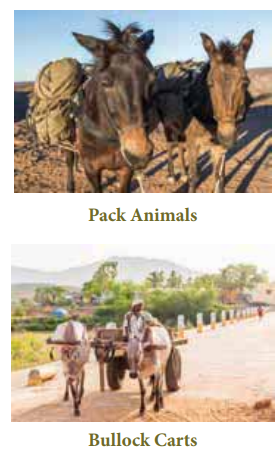Chapter: 11th Commerce : Chapter 14 : Transportation
Surface Transport
Surface Transport
Transport of people and goods by land
vehicles is known as Surface transport. It is also called as ‘Land Transport’.
1. Pack Animals
Animals like horse, mule, donkey camel,
and elephant etc., are used for carrying small loads in backward areas, hilly
tracks, forest regions and deserts known as pack animals. Generally, the pack
animals serve areas which are inaccessible to modern means of transport. Animal
transport has also played a significant role where there is no road and railway
transport.

2. Bullock Carts
It constitutes the predominant form of rural road transport in India for goods traffic and to some extent for passengers’ traffic. It links up the villages with the nearby markets and railway stations. It carries the produce for sale to the market and consumer goods to the villages.
3. Road Transport
Road Transport is one of the most
promising and potent means suitable for short and medium distances. It provides
the basic infrastructure for bringing the majority of the people who are living
in far-off villages into the mainstream of nation like by connecting them to
different places. It offers a number of advantages such as flexibility,
reliability, speed and door-to-door service, besides supplementing and
increasing the efficiency of the other modes of transport.
4. Motor Lorries and Buses
From the dawn of civilization, people have been endeavoring to form roads and use wheeled vehicles to facilitate transport of men and materials. The credit of revolutionizing the road transport and introducing the elements of speed and greatercarryingcapacityintothesystemgoes to motor lorries and buses. Introduction of petrol engine and later diesel engine vehicle has been offering good competition to the railways.
5. Tramways
It made their appearance in the 19th
century as a form of transport suitable for big cities. Tramways were
initially horse drawn
later steam-powered and now electrically operated. Its carrying capacity
is large. They are able to cope up with the peak hour traffic in big cities
with the greater popularity of motor buses, tramways slowly declined. Madras
city had tramways till 1933.

6. Railway Transport
The invention of steam engine by James
Watt, revolutionized the mode of transport all over the world. Railway, as a
mode of transport is the most organized transport undertaking all over the
world. Railways are the cheapest and quickest means of transport for carrying
heavy goods over long distance.
Railways render an essential public service. It requires a huge capital outlay for laying of tracks, construction of bridges, purchase of locomotives etc. Railways are among the biggest public utilities of a country.
Rail transport is a means of transferring of
passengers and goods on wheeled vehicles running on rails (tracks). Rail
transport stated to be important in the Industrial Revolution.
There are three types of tracks that are
in operation. They are (I) Meter gauge (ii) Broad gauge and (iii) Narrow gauge
Related Topics